Resident Evil, or Biohazard in Japan and parts of Southeast Asia, is a Japanese horror game series and media franchise created by Capcom. It consists of survival horror, third-person shooter and first-person shooter games, with players typically surviving in environments inhabited by zombies and other frightening creatures. The franchise has expanded into other media, including a live-action film series, animated films, television series, comic books, novels, audio dramas and merchandise. Resident Evil is the highest-grossing horror franchise.

Resident Evil 2 is a 1998 survival horror video game developed and published by Capcom for the PlayStation. The player controls rookie cop Leon S. Kennedy and college student Claire Redfield, who must escape Raccoon City after its citizens are transformed into zombies by a biological weapon two months after the events of the original Resident Evil. The gameplay focuses on exploration, puzzles, and combat; the main difference from its predecessor are the branching paths, with each player character having unique storylines, partners and obstacles.

Resident Evil 3: Nemesis is a 1999 survival horror video game developed and published by Capcom originally for the PlayStation. It is the third game in the Resident Evil series and takes place almost concurrently with the events of Resident Evil 2. The player must control former elite agent Jill Valentine as she escapes from Raccoon City, which has been infected by a virus. The game uses the same engine as its predecessors and features 3D models over pre-rendered backgrounds with fixed camera angles. Choices through the game affect how the story unfolds and which ending is achieved.

Resident Evil Zero is a survival horror video game developed and published by Capcom for the GameCube in 2002. It is a prequel to Resident Evil (1996), covering the ordeals experienced in the Arklay Mountains by special police force unit, the S.T.A.R.S. Bravo Team. The story takes place in July 1998 and follows officer Rebecca Chambers as well as convict Billy Coen as they explore an abandoned training facility for employees of the pharmaceutical company Umbrella. The gameplay is similar to other Resident Evil games, but adds the ability to switch between characters to solve puzzles and use unique abilities.

Resident Evil is a 1996 survival horror game developed and published by Capcom for the PlayStation. It is the first game in Capcom's Resident Evil franchise. Players control Chris Redfield and Jill Valentine, members of the elite task force S.T.A.R.S., who must escape a mansion infested with zombies and other monsters.

Resident Evil Outbreak is a survival horror video game developed and published by Capcom for the PlayStation 2. It was released on December 11, 2003 in Japan, on March 30, 2004 in North America, and on September 17, 2004 in PAL regions. It was the first entry in the Resident Evil video game series to feature cooperative gameplay and online multiplayer support, although online support was not available for the PAL versions of the game.

Resident Evil Outbreak: File #2 is a survival horror video game developed and published by Capcom with online playability for the PlayStation 2. It is the sequel to Resident Evil Outbreak, and the final installment of the spin-off series. It was released on September 9, 2004 in Japan, on April 26, 2005 in North America, and August 26, 2005 in PAL regions.

Resident Evil: Dead Aim is a light gun shooter video game developed by Cavia and published by Capcom. It is the third Gun Survivor title in the Resident Evil series, and the fourth and final installment in the Gun Survivor series. It is also the third in the franchise to feature first-person shooting in the Resident Evil series.
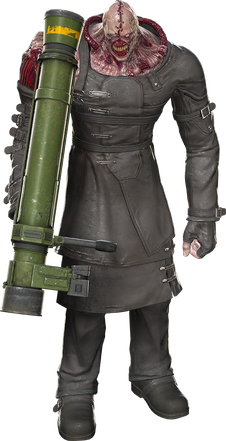
The Nemesis, also called the Nemesis-T Type, or the Pursuer, is a character in Resident Evil, a survival horror video game series created by the Japanese company Capcom. Although smaller than other Tyrant models, the creature dwarfs a typical human, and possesses vastly superior intelligence and physical dexterity to its undead peers. It is featured in Resident Evil 3: Nemesis (1999) as a titular main villain before later emerging in other titles and cameo roles. It is also featured on various merchandise and was portrayed by Matthew G. Taylor in the 2004 film Resident Evil: Apocalypse. The character is voiced by Tony Rosato in the original game and Gregg Berger in Operation Raccoon City (2012). In the 2020 remake of Resident Evil 3, the character is voiced by David Cockman, with Neil Newbon providing the motion capture performance. Nemesis has also been featured in several other game franchises, including as a playable character in Marvel vs. Capcom and Dead by Daylight.

Resident Evil: The Umbrella Chronicles is an on-rails light gun shooter video game developed by Capcom and Cavia as part of the Resident Evil series. The game was released for the Wii on November 13, 2007, in North America; November 15, 2007, in Japan; and on November 30, 2007, in Europe, excluding Germany, where the game is not available due to the refusal of a USK rating and its subsequent inclusion in the index. It was followed by Resident Evil: The Darkside Chronicles. Both Chronicles games are included on the Resident Evil Chronicles HD Collection for the PlayStation 3.
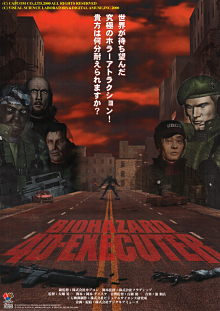
Biohazard 4D-Executer is a 2000 Japanese 3D animated biopunk horror film based on the Resident Evil series of survival horror video games. It was created by Capcom in cooperation with Visual Science Laboratory, and distributed by Digital Amuse. Biohazard 4D-Executer was directed by Koichi Ohata, and written by Daisuke Okamoto, who was supervised by the game series developers. A limited release, the 20-minute film has been an attraction in Japanese theme parks since November 2000, and can be seen in movie theaters and smaller booths. The story centers on the mission of a military squad sent to the zombie-infested Raccoon City to locate the whereabouts of Dr. Cameron, a female scientist conducting research on a new type of virus.

Resident Evil: Degeneration, known as Biohazard: Degeneration in Japan, is a 2008 Japanese adult animated biopunk action horror film directed by Makoto Kamiya. It is the first full-length motion capture animation feature in Capcom's Resident Evil franchise. The film was made by Capcom in cooperation with Sony Pictures Entertainment Japan. Degeneration made its premiere at the 2008 Tokyo Game Show and was released theatrically on October 17, 2008.
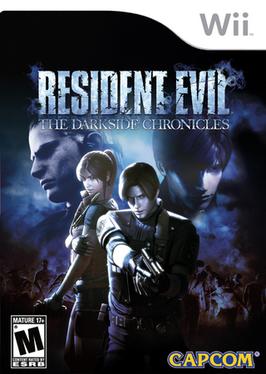
Resident Evil: The Darkside Chronicles is an on-rails light gun shooter video game for the Wii developed by Capcom and Cavia as part of the Resident Evil series. The game was released for the Wii on November 17, 2009, in North America. It serves as a prequel to Resident Evil 4, set 2 years before its events. It was released in Europe on November 27, 2009, bundled with the Wii Zapper accessory.

Resident Evil: Operation Raccoon City is a squad-based third-person shooter video game for Microsoft Windows, PlayStation 3 and Xbox 360, co-developed by Slant Six Games and Capcom. It was released on March 20, 2012 in North America, March 22, 2012 in Australia, March 23, 2012 in Europe and April 26, 2012 in Japan.
Starting with Biohazard i Survivor in 2001, several mobile games based on the Resident Evil survival horror franchise have been released. The games feature different genres and settings, and were developed by the Japanese and Canadian branches of Capcom.
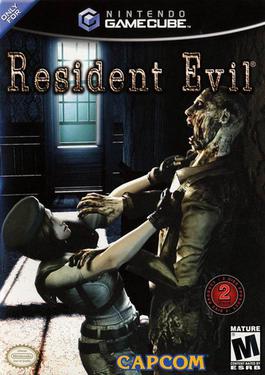
Resident Evil is a survival horror video game developed and published by Capcom. Released for the GameCube video game console in 2002, it is a remake of the 1996 PlayStation game Resident Evil, the first installment in the Resident Evil video game series. The story takes place in 1998 near the fictional Midwestern town of Raccoon City where a series of bizarre murders have taken place. The player takes on the role of either Chris Redfield or Jill Valentine, S.T.A.R.S. officers sent in by the city and the R.P.D. to investigate the murders.

Resident Evil Survivor 2 – Code: Veronica is a light gun shooter video game developed and published by Capcom as part of the Resident Evil series. The arcade version was developed in conjunction with Namco for the arcade machines. The game was released for Sega NAOMI and PlayStation 2. It was released on the PlayStation 2 on November 8, 2001 in Japan and in Europe on March 22, 2002. Whilst the Playstation 2 release is a light gun shooter, the NAOMI arcade release features no lightgun technology whatsoever, instead deferring control of each player entirely to a three-axis joystick in the shape of a gun. The game is the second instalment in the Gun Survivor series and the sequel to Resident Evil Survivor. The game is adapted from Resident Evil – Code: Veronica and features enemies and characters from that game, and enemies from Resident Evil 2 and 3. It was followed by Dino Stalker which is a spin-off of Dino Crisis, and has no ties to Resident Evil.

Umbrella Corps is a 2016 tactical shooter game developed and published by Capcom. Released for Microsoft Windows and PlayStation 4, it is a spin-off of the Resident Evil series and was released worldwide in June 2016. The game received negative reviews from critics.
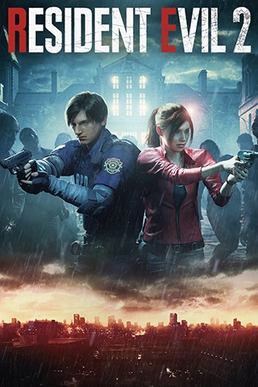
Resident Evil 2 is a 2019 survival horror game developed and published by Capcom. A remake of the 1998 game Resident Evil 2, it was released for PlayStation 4, Windows, and Xbox One in January 2019 and for Amazon Luna, PlayStation 5 and Xbox Series X/S in June 2022, and a Nintendo Switch cloud version released in November 2022. Players control the rookie police officer Leon S. Kennedy and the college student Claire Redfield as they attempt to escape Raccoon City during a zombie outbreak.

Resident Evil: Resistance is a 2020 survival horror game developed by NeoBards Entertainment and published by Capcom as the online component for Resident Evil 3. Released for PlayStation 4, Windows, and Xbox One, it involves four survivor players competing against a mastermind player who can create traps, enemies and other hazards. Resistance is set during the Raccoon City outbreak, featuring some of the characters from Resident Evil 2 and 3. It is non-canon as producer Peter Fabiano confirmed it is "impossible to fit in the actual timeline". The game received mixed reviews from critics, who criticized the game for being unbalanced, having technical issues and for lacking dedicated servers.


















